Hindu vrat (vrata) (vow, resolve, devotion) list (names with explanation)
Namaste friends, how are you doing today? Welcome to #BhagavanBhakthi website / blog.
Bhagavan Lord Sri Krishna (Vishnu) (Rama) and Goddess Rukmini (Lakshmi) (Sita) blessings to you and your family!
In this website / blog, you will always learn about #Hinduism #Sanskrit language.
Also subscribe to my YouTube channel from this link #BhagavanBhakthi to view videos about #Hinduism #Sanskrit language.
Just before going to “Hindu vrat (vrata) (vow, resolve, devotion) list (names with explanation)“, let us know a brief, basic and very important information.
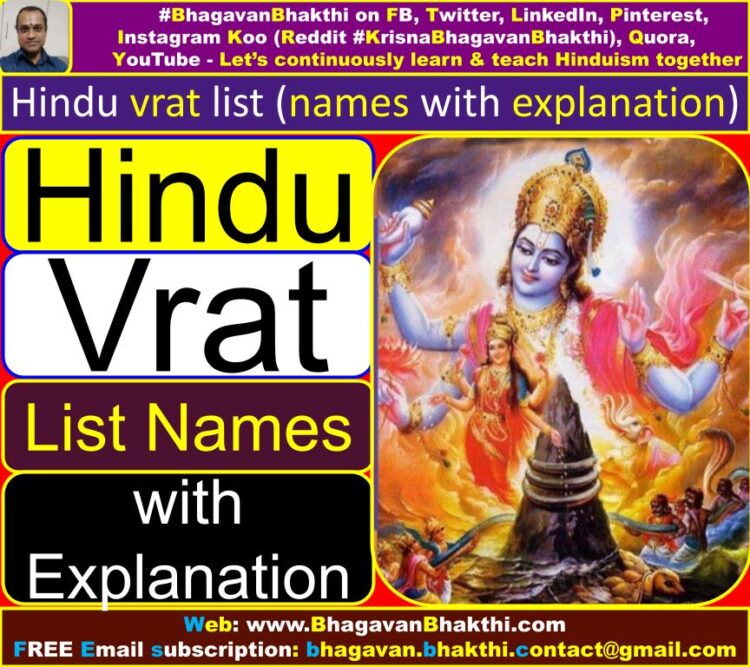
Note : Below information source is from “Varaha Purana“.
India or Bharata is the oldest nation of this earth. India has all the divine ingredients which are required for the upliftment of any person, both materially and spiritually. Among that, Vrata plays a prominent role.
Vrata (Vrat) is a Sanskrit word that means “vow, resolve, devotion, something which we do to make Lord Sri Hari (Vishnu) and / or other Devatas (Demigods) happy”. And Vrata (Vrat) refers to pious observances such as doing pooja, fasting and pilgrimage (Tirtha) found in Indian religions.
It is typically accompanied with prayers seeking health and happiness for their loved ones as examples for material benefits and for seeking moksha / mukti & related for Godly benefits.
First let’s look at the different vrata (vrat) names and then later, let us see the explanation.
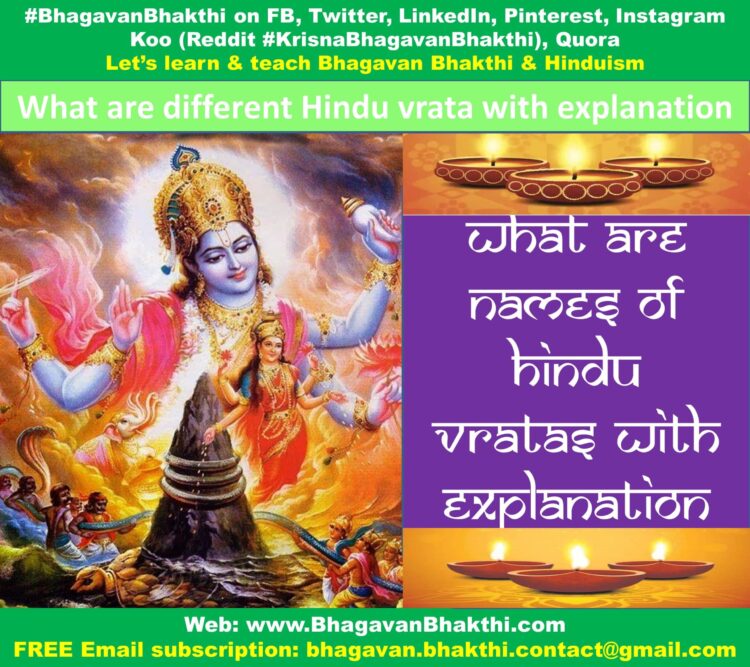
List of Hindu Vrat (Vrata) names is as given below:
1. MATSYA-DWADASHI VRATA | 2. KURMA-DWADASHI VRATA | 3. VARAHA-DWADASHI VRATA | 4. NRISIMHA-DWADASHI VRATA | 5. VAMANA-DWADASHI VRATA | 6. JAMDAGNYA-DWADASHI VRATA |
7. KALKI-DWADASHI VRATA | 8. PADMANABH-DWADASHI VRATA | 9. DHARNI-VRATA | 10. BUDDHA-DWADASHI VRATA | 11. SHUBHA-VRATA | 12. DHANYA-VRATA | 13. KANTI-VRATA | 14. SAUBHAGYA-VRATA | 15. AVIGHNA-VRATA |
16. SHANTI-VRATA | 17. KAAMA-VRATA | 18. AAROGYA-VRATA | 19. PUTRA-PRAPTI VRATA 20. SHAURYA AND SARVA BHAUMA VRATA |
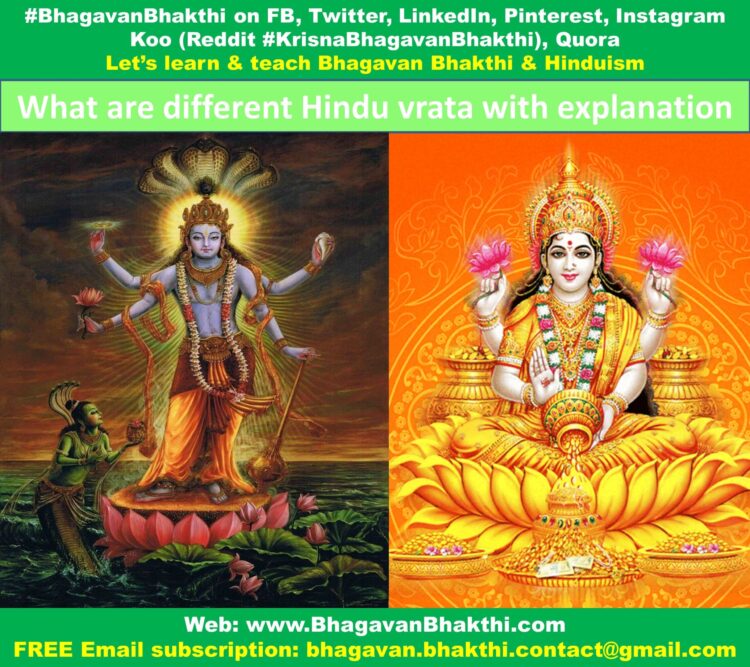
MATSYA-DWADASHI VRATA : Matsya-dwadashi is celebrated on the twelfth day of hindu month-Margashirsha. On this auspicious day a devotee should worship Lord Matsya – the incarnation of lord Vishnu with appropriate rituals and give charity to brahmins.
Prithvi was the first one to observe this particular austerity while she was being abducted to rasatala by a mighty demon named Hiranyaksha.
A devotee who observes a fast on this day and worships lord Matsya with appropriate rituals attains to Brahma loka and remains their for eternity. Such a person attains a divine body when creation recommences after the period of deluge.
An issue-less woman is blessed with a virtuous son if she observes a fast on this day. Matsya-dwadashi is capable of absolving a man even of the gravest of his sin.
KURMA-DWADASHI VRATA : This particular austerity is dedicated to the worship of Lord Kurma-the incarnation of Lord Vishnu. It is celebrated on the twelfth day of the bright half of the hindu month ‘pausha’.
The austerity which commences on the tenth day itself when a devotee is supposed to purify himself by taking a holy bath.
On the following day he observes a fast and worships Lord Kurma with appropriate rituals. He breaks his fast on dwadashi which marks the conclusion of the austerity. A devotee who observes a fast on this auspicious day becomes absolved of all his sins and attains salvation.

VARAHA-DWADASHI VRATA : Varaha dwadashi is celebrated on the twelfth day of the bright half of the Hindu month-magha. This was the day on which Prithvi had been rescued by Lord Varaha-the incarnation of Lord Vishnu.
An idol of Lord Varaha is installed on a pot filled with water and worshipped with appropriate rituals amidst the continuous chanting of the mantra-‘om varahaya namaha’.
Offerings of various articles are made while worshipping Lord Varaha-sandal wood, incense, naivedya, etc.
After the accomplishment of the rituals brahmins are fed and charity given to them. One who observes a fast on this day enjoys a good health and prosperity. Such a man becomes absolved of all his sins and attains to heaven after his death.
NRISIMHA-DWADASHI VRATA : This austerity is observed on the twelfth day of the bright half of the hindu month-phalguna. A devotee should observe fast on this day and worship Lord Nrisimha with appropriate rituals. This particular austerity is capable of absolving a man from all his sins.
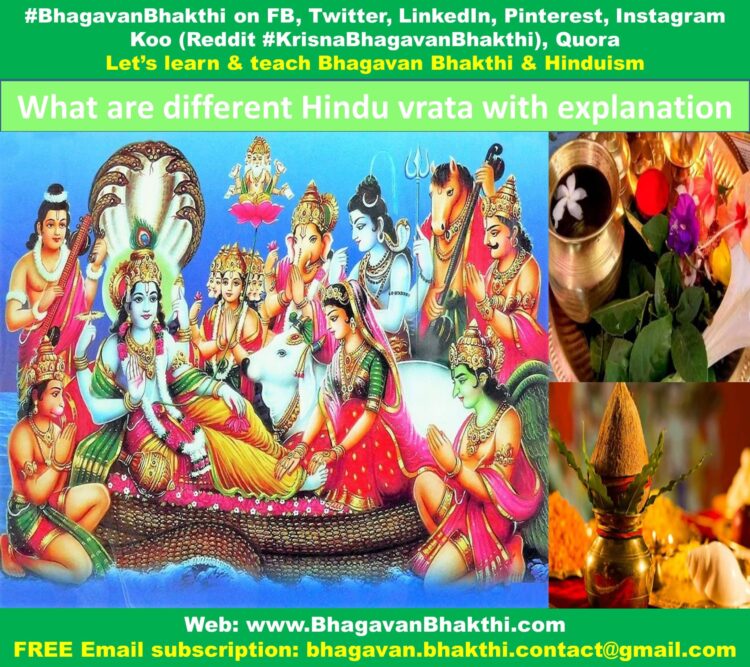
VAMANA-DWADASHI VRATA : Vaman dwadashi is celebrated on the twelfth day of the bright half of the Hindu month-chaitra. A devotee should observe a fast and worship Lord Vaman by saying the following prayer –
“Lord Vamana-the dwarfish incarnation of the almighty Vishnu, who took incarnation on the auspicious day of dwadashi in the month of chaitra-I seek your blessings.” One who observes a fast on this day is blessed and protected from all kinds of danger.
JAMDAGNYA-DWADASHI VRATA : This austerity is related with the worship of Lord Parshurama who is also famous as Jamdagnya. It is celebrated on the twelfth day of the bright half of the hindu month-vaishakha.
Before commencing the rituals, a devotee should purify himself by taking a bath and then worship an idol of Lord Parshurama kept on a pot filled with water.
While worshipping he should make offerings of various articles to the deity-flowers, sandalwood, ardhya, etc.
It is mandatory to remain awake for the whole night. On the following day, he should donate the idol to a brahmin. A devotee who observes a fast on this day gets all his wishes fulfilled and attains to Brahma Loka.
KALKI-DWADASHI VRATA : A devotee should commence this austerity by observing a fast on the eleventh day of the bright half of the hindu month-bhadrapada and break it on the following day-dwadashi. He should worship lord Kalki with appropriate rituals.
As per the norms of the rituals, the idol of Lord Kalki is placed on a pot which is filled with water. This idol is donated to a learned brahmin on the following day-trayodashi.
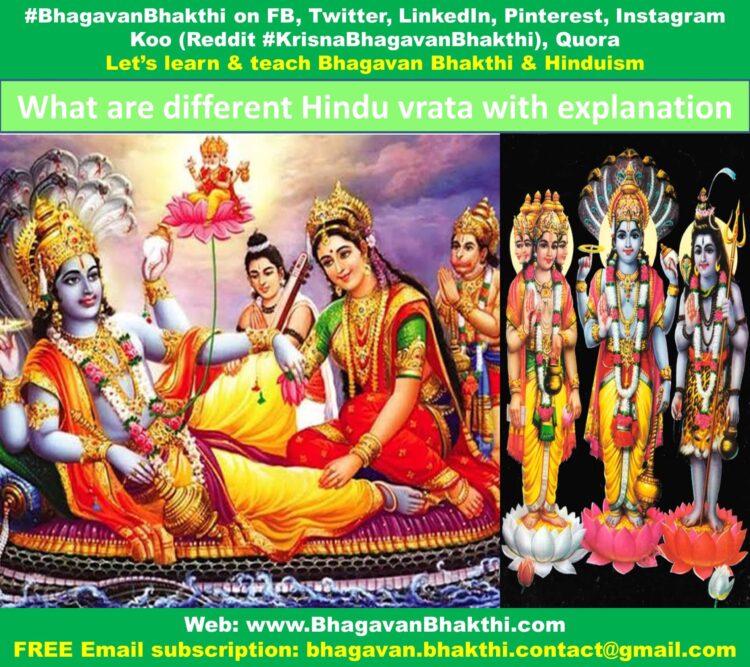
PADMANABH-DWADASHI VRATA : This austerity is related with the worship of Lord Padmanabha – an epithet of Lord Vishnu and is observed on the twelfth day of the bright half of the hindu month-ashwini. One important characteristic of the ritual is that all the organs of Lord Padmanabha is worshipped.
The idol is placed on a pot filled with water and while worshipping offerings of various articles are made-flowers, fruits, sandalwood, etc.
On the following day the idol is donated to a brahmin. One who observes a fast on this day enjoys a prosperous life and attains to the abode of Lord Padmanabha.
DHARNI-VRATA : This particular austerity is observed in the hindu month of Kartika. The rituals commence by worshipping various organs of Lord Narayana amidst the chanting of different mantras which are as follows-
om sahastra shirse namaha – head | om purushaye namaha – arms | om vishwa rupine namaha – throat | om gyanastraye namaha – weapons |
om shri vatsaaya namaha – chest | om jagad grasishnave namaha – abdomen | om divya murtaye namaha – waist | om sahastra padaye namaha – feet |
Similarly, Sri Krishna dwadashi is celebrated in the hindu month of Ashadha, shukla- paksha. A devotee should worship Lord Krishna on this day and observe a fast.
BUDDHA-DWADASHI VRATA : Lord Buddha is believed to be the incarnation of Lord Vishnu. The austerity begins on the eleventh day of the bright half of the hindu month-shravana.
On this day Lord Vishnu is worshipped with appropriate rituals and by making offerings of various articles like flowers, fruits, incense, etc.
The following mantras should be chanted while worshipping the various organs of Lord Vishnu –
om damodaraya namaha – feet | om hrishikeshaya namaha – waist | om sanatanaya namaha – abdomen |
om shri vatsadharine namaha – chest | om chakrapanaye namaha – arms | om haraye namaha – throat | om manju keshaya namaha – head | om bhadraya namaha – top-knot (shikha) |
After the accomplishment of the rituals, the idol should be donated to a brahmin.
SHUBHA-VRATA : This particular austerity on the first day of the hindu month-margashirsha.
It is related with the worship of Lord Vishnu and the rituals have some special characteristics-having one meal on the eleventh day of the month (ekadashi), donating barley to brahmins, worshipping the idol of goddess Prithvi on ‘ekadashi’, etc.
The austerity concludes on dwadashi. On ekadashi, goddess Prithvi is also worshipped alongwith Lord Vishnu. Both the idols are installed side by side and covered with white clothes.
After that some rice grains are scattered in front of both the idols. As per the norms of the rituals, a devotee is required to remain awake for the whole night. Next morning, he should invite twenty-four brahmins and feed them.
He should also donate a cow, apparels, ornaments, an umbrella, woodden sandle and similar articles to them. A devotee who observes a fast on this auspicious day enjoys prosperity.
DHANYA-VRATA : This particular austerity is a form of ‘nakta-vrata’, which means observing fast for the whole day and breaking it in the night. The austerity commences on the first day of the bright half of the hindu month-aghana and lasts for a year.
Rituals include worshipping Agnideva-an embodiment of Lord Vishnu, chanting of certain mantras praising the glory of the deity and performing ‘havana’.
There are specific instructions on the type of food a devotee should have during the course of this austerity-for four months (chaitra to ashadha) he should have delicacies like ‘kheer’ seasoned in pure ghee.
From shravana to kartika he should have food-items prepared from gram-flour. This way, the austerity lasts for one year whereby a devotee observes fast on the first day of every month that follows. The austerity concludes by worshipping an idol of Lord Agni made of gold.
The idol is adorned with a piece of red-cloth and red-flowers are offered to the deity while worshipping. After the rituals are accomplished, the idol should be donated to a brahmin. The observance of this particular austerity brings good fortune to a man and makes him prosperous.
KANTI-VRATA : This austerity is related with the worship of Sri Krishna and Balaram. It commences on the second day of the bright half of the hindu month-kartika and lasts for an year whereby a devotee observes fast on the second day (bright half) of every month that follows.
While worshipping Balarama, a devotee should chant-‘om baldevaya namaha’ and while worshipping Sri Krishna he should chant-‘om keshavaya namaha’. Subsequently, ‘ardhya’ is offered to both the deities.
A devotee should have food prepared from barley-flour in the night but those devotees who have resolved to observe this austerity for four months beginning from ‘falguna’ should live only on ‘kheer’.
Offerings of rice and sesame seeds are made in the sacrificial- fire during the months of ‘aghana’ and ‘kartika’ respectively. The rituals conclude by worshipping the deity ‘Chandrama’ at the end of the year.
Finally all the three idols (Sri Krishna, Balrama and Chandrama) should be donated to brahmins. A devotee who observes this austerity is bestowed with a charming personality.
SAUBHAGYA-VRATA : This austerity commences on the third day of the bright half of the hindu month-falgun and lasts for a year whereby a devotee observes fast on the third day (bright half) of every month that follows.
According to the tradition a devotee can either worship ‘Shiva-Parvati’ or ‘Sri Hari-Laxmi on this auspicious day.
While worshipping, the devotee should chant the following mantras: om gambhiray namaha, om saubhagyay namaha, om devadevaya namaha, om trinetraya namaha, om vachaspataye namaha, om rudraya namaha, etc.
One important feature of the rituals is making offerings of honey and ghee to the sacrificial fire. During the course of the rituals,a devotee should have food prepared from pure cereals preferably wheat.
After the rituals are accomplished at the end of the year, the idols should be donated to brahmins. One who observes this austerity is blessed with good fortune in his successive seven births.
AVIGHNA-VRATA : As the name implies, this austerity clears all the obstacles faced by a man. It commences on the fourth day of the bright half of the Hindu month-falguna and lasts for four months whereby a devotee observes fast on the fourth day (bright half) of every month that follows.
One important characteristic of this austerity is the importance and use of sesame seeds in it’s rituals. It is not only the chief constituent of the diet but it is also offered in the sacrificial fire and donated to the brahmins as well.
After observing this austerity for four months, a devotee should conclude it by worshipping Lord Ganesh in the fifth month and donating the Ganesh-idol to a brahmin along with five pots filled with sesame seeds.
While worshipping Lord Ganesh, he should chant the following mantras: om shooraya namaha, om dhiraya namaha, om gajananaya namaha, om lambodaraya namaha, om ekadantaya namaha, etc.
A devotee thus becomes free from all kind of obstacles and all his wishes are fulfilled.
SHANTI-VRATA : This austerity commences on the fifth day of the bright half of the hindu month-kartika and lasts for a year whereby a devotee observes fast on the fifth day (bright half) of the every month that follows.
It is related with the worship of Lord Vishnu and Sheshanaga. A devotee should abstain from hot and spicy food during the course of this austerity.
Lord Vishnu’s idol is purified by chanting mantras and by performing ablution with milk. Offerings of sesame seeds and milk are made in the sacrificial fire. After the accomplishment of the rituals at the year end, brahmins are invited and fed. Finally, the idol of Sheshanaga is donated to one of them.
A devotee who performs this austerity becomes free from all kinds of turbulence in his life and experiences peace and tranquility.
KAAMA-VRATA : This austerity is related with the worship of Lord Kartikeya and is observed in the bright half of the hindu month-paushya. On the sixth day of this month, a devotee is expected to live on nothing else but fruits.
Lord Kartikeya is also known by several other names-Shadanana, Senani, Kritikasuta, Kumara, Skanda, etc. The austerity concludes by feeding the brahmins at the year end and making donations to them. A devotee who observes this austerity gets all his wishes fulfilled.
AAROGYA-VRATA : This austerity is related with the worship of Lord Surya Narayan who is also known by several other names like Aaditya, Bhaskara, Ravi, Bhanu, Diwakara, Prabhakara, etc.
A devotee should observe a fast on the seventh day of any month and worship Lord Suryanarayana. The fast should be broken on the next day-ashtami.
A devotee can continue this ritual for one year following the above mentioned rituals. A devotee who observes the rituals of this austerity becomes free from all kind of diseases and enjoys a healthy life.
PUTRA-PRAPTI VRATA : This austerity commences on the eighth day of the bright half of the hindu month-bhadrapada. The rituals consist of taking a ‘sankalpa’ on the preceding day (saptami) and worshipping Lord Sri Hari on the next day with appropriate rituals.
Offerings are made to the sacrificial fire, which usually consist of articles like barley, sesame seeds, ghee, etc. The austerity concludes by feeding the invited brahmins and making donations to them.
This way, the austerity continues for a year whereby a devotee observes fast on ‘ashtami’ of every month. A son less person is blessed with a son if he observes this austerity with total devotion.
This austerity, which is popularly known as ‘Krishna ashtami’ also helps a devotee to become absolved of gravest of sin.
SHAURYA AND SARVA BHAUMA VRATA : Shaurya and Sarva Bhauma vrata is related with the worship of goddess Durga and is observed on the nineth day of the bright half of the hindu month-ashvini.
The rituals commence by taking a ‘sankalpa’ as well as observing a fast on the preceding day (saptami). The fast is broken on the next day (ashtami) by having fruits. Cereals are excluded from the diet. One important aspect of this austerity is the worship of virgin girls along with goddess Durga.
One who observes the rituals of this austerity attains power valour and strength. Sarva bhauma vrata is related with the worship of all the ten directions, considered as goddesses.
A fast is observed on the tenth day of the bright half of the hindu month-kartika and lasts for a year whereby a devotee observes fast on the tenth day (bright half) of every month that follows.
One important characteristic of this fast is that it is broken at the end of the day by having rice and curd. Making sacrifices in the name of all the ten directions are the inseparable part of this austerity.
A devotee, who observes this austerity lasting for a year remains invincible in whatever he does.
PS: This has been taken from Varaha Purana
Read more about Hindu Sanskars (Samskaras) : Hindu Sanskars (Samskaras) information, importance, significance etc.
More information will be added to his post (article) on regular basis. Please visit again to know the updated information after some time.
To watch videos on #Hinduism #Sanskrit language, SUBSCRIBE to my YouTube channel from this below link:
#BhagavanBhakthi YouTube channel
To know more about “Vedas information, facts, significance, means, etc.“, please click the below link:
Vedas information, facts, significance, importance, meaning, etc.
Continue reading about “List of Hindu texts names (With basic information) (scriptures) (Granthas) (Holy Books) (treatise)” from these below links:
List of Hindu texts names – Part 1 of 4 (With basic information)
Dear friends, if you need any clarifications about this post, kindly let me know, I will definitely try to answer all of them.
Also your one LIKE, one COMMENT, One Share, one SUBSCRIPTION is highly important.
This will help to know the quality of this content and also it will be helpful to know if any improvements is required for the content.
If you feel this content is useful to you and has helped you to improve your knowledge, kindly share this with your well-wishers. Because “SHARING MEANS CARING”.
To receive FREE EMAIL SUBSCRIPTION about #BhagavanBhakthi, you can send an email to bhagavan.bhakthi.contact@gmail.com from your email ID.
NAMASTE!
Sri Gurubhyo namaha
Om Sri Krishnaaya namaha
Sri Krishnaarpanamastu
Share in Social Media